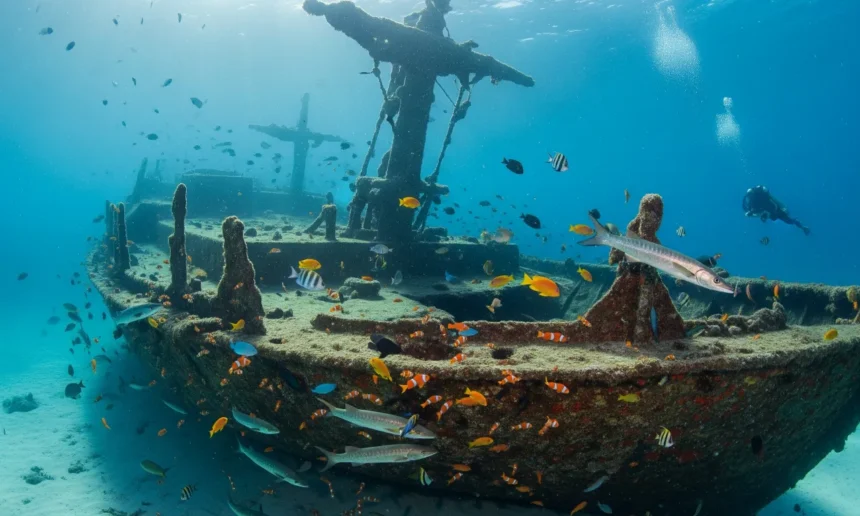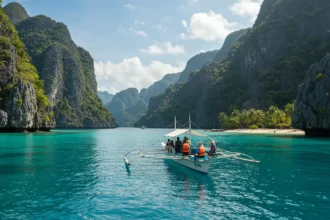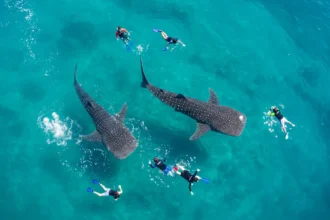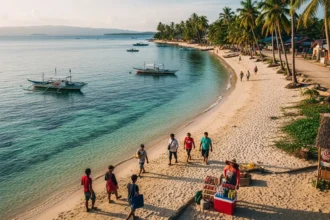💙 The Sea’s Playground: Where Adventure Meets the Deep
Imagine swimming over a ghost ship – silent, massive, and blanketed by colorful corals. Fish dart through broken windows, sunlight filters through the hull, and you’re just… floating in awe. Galing, ‘di ba? This is the magic of Philippine shipwrecks – a mix of mystery, beauty, and thrill that makes every dive feel like time travel.
- 💙 The Sea’s Playground: Where Adventure Meets the Deep
- 🌊 Why the Philippines Is the Ultimate Wreck Diving Destination
- ⚓ Must-Dive Shipwrecks in the Philippines (and What Makes Them Epic)
- 🐠 Hidden Wreck Diving Gems Around the Philippines (Off-the-Beaten-Path Sites)
- 🤿 Wreck Diving Tips for Beginners and Adventure-Seekers in the Philippines
- 💬 FAQs About Wreck Diving and Philippine Shipwrecks
- 💙 Beneath the Waves, the Adventure Lives On
- 🧭 References
Each wreck tells a story. Some sank during World War II, others were lost to storms or hidden reefs. But what’s left behind? A breathtaking underwater world – coral gardens blooming from steel, schools of jackfish swirling like silver storms, and artifacts resting quietly in the sand.
For thrill-seekers, divers, and ocean lovers, these shipwrecks aren’t just relics – they’re living adventures. Every descent feels like a treasure hunt: new angles, new creatures, new secrets waiting to be found beneath the waves.
The Philippines, with its 7,000+ islands, is literally an open-water museum. From Coron’s hauntingly beautiful WWII wrecks to Subic’s training-friendly sunken ships, it’s a paradise for wreck divers – beginners and pros alike. So if you’ve ever dreamed of gliding through history while surrounded by marine life, this is your sign to dive in.
Beneath the waves, history breathes… and adventure begins.
🌊 Why the Philippines Is the Ultimate Wreck Diving Destination
Ever wonder why Philippine shipwrecks are so famous around the world? Simple. The Philippines sits right at the crossroads of history – and of the Pacific Ocean’s most dramatic moments. From Spanish galleons to Japanese warships, our waters have seen it all.
But here’s the twist – what used to be tragic sinkings are now stunning underwater playgrounds. Over time, nature reclaimed these wrecks. Coral started to grow on rusted steel, fish made homes in the cabins, and divers? Well, they started lining up just to experience it all.
Places like Coron in Palawan are now legendary – home to a dozen WWII wrecks perfectly preserved in turquoise waters. Each dive feels like entering a time capsule: bomber planes, warships, and cargo vessels frozen mid-sink, surrounded by life again. Meanwhile, Subic Bay in Zambales offers easier access for beginners – shallower depths, calm currents, and incredible visibility.
Even Visayas and Mindanao have their share of underwater secrets – some barely mapped, waiting for the next curious soul to discover them.
So if you think shipwrecks are only for history buffs, think again. They’re for adventurers – for anyone craving the mix of thrill, beauty, and mystery that only the deep blue can offer.
Every wreck has a story. And every story begins when you dive.
⚓ Must-Dive Shipwrecks in the Philippines (and What Makes Them Epic)
Each Philippine shipwreck has its own vibe – some eerie, some majestic, all unforgettable. Whether you’re a seasoned diver or a newbie still getting used to your fins, these wrecks will pull you in (literally and emotionally). Here are some of the most iconic dive sites where history meets adrenaline.
🌅 1. The WWII Wrecks of Coron, Palawan
If there’s a wreck diving capital in the Philippines, Coron is it – no debate. These Japanese warships were sunk during World War II, now resting peacefully beneath crystal waters.
Each dive feels cinematic: swim through the Irako Maru, glide above the Akitsushima, or peer into the Olympia Maru’s haunting corridors. You’ll see rusted guns covered in coral, schools of fish flashing like confetti, and sunlight slicing through broken hulls.
It’s not just diving – it’s like touching history with your bare hands.
⚓ 2. Subic Bay, Zambales – The Ocean Classroom
Closer to Manila but packed with adventure, Subic Bay is a favorite for both beginners and technical divers. The wrecks here vary – from the Spanish-American War’s San Quentin to the more recent USS New York, a massive armored cruiser that’s both intimidating and mesmerizing underwater.
Visibility is good, the currents are manageable, and there are plenty of dive shops offering guided wreck tours. For many, Subic is where they fall in love with wreck diving.
🐠 3. Camiguin’s Sunken Cemetery
Okay, technically not a shipwreck – but it deserves a spot here. When a volcano erupted in the 1870s, part of Camiguin Island sank, including its old cemetery.
Today, divers and snorkelers explore this surreal underwater site, marked by a giant cross above water. Coral-covered gravestones and sea creatures now coexist peacefully – creepy yet calming, strange yet beautiful.
Trust me, the vibe here? Otherworldly.
🪸 4. The Visayan Mysteries – Leyte, Bohol, and Cebu
Scattered across the Visayas are smaller wrecks – lesser-known, less crowded, but equally fascinating. In Malapascua, you can mix wreck diving with thresher shark encounters (talk about bragging rights!).
Leyte Gulf has remnants of WWII vessels, while Bohol’s Panglao offers beginner-friendly wrecks teeming with tropical fish. These sites prove that you don’t need fame to be fantastic – just a good sense of adventure.
🌊 5. Samal Island & Davao Gulf
For divers down south, Davao Gulf hides some real treasures. The Mati wrecks and Talikud Island sites are slowly making waves (pun intended) among local dive communities. Expect healthy coral reefs, dramatic underwater slopes, and the occasional surprise – like spotting sea turtles gliding past rusted anchors.
🐠 Hidden Wreck Diving Gems Around the Philippines (Off-the-Beaten-Path Sites)
Not every Philippine shipwreck makes it to travel brochures – and that’s exactly what makes them special. These hidden gems may be remote, but if you’re up for the challenge, the payoff is insane. Fewer crowds, raw beauty, and that sweet feeling of discovering something not everyone’s seen.
🌴 1. Apo Island, Negros Oriental
Apo’s mostly known for sea turtles and vibrant reefs – but its small, unnamed wrecks are perfect for divers who want something different. Expect shallow dives, soft corals, and close encounters with sea snakes, clownfish, and the occasional turtle photobombing your shot.
🚤 2. Cuyo Islands, Palawan
Between Coron and Iloilo lies a diver’s secret – Cuyo. It’s remote (as in, “you’ll lose signal halfway there” kind of remote), but the reward is pristine waters and mysterious wrecks believed to be old trading vessels. Locals even whisper about Spanish-era galleons still buried under layers of sand and coral.
Who knows, baka ikaw pa ang unang makakita.
🧭 3. Tubbataha Reefs, Sulu Sea
A UNESCO World Heritage Site and diver’s paradise. While Tubbataha is known for walls and pelagics, there’s also the Malayan Wreck, which sits dramatically along one of the park’s reef edges. Only accessible during dive season (March–June), it’s a must for serious divers chasing bucket-list dives.
🐬 4. Surigao Strait, Eastern Mindanao
The Surigao Strait was the site of a massive WWII naval battle – meaning wrecks are everywhere, though many remain uncharted. Advanced divers have reported aircraft parts, scattered metal debris, and coral-covered ship sections. Exploring here feels like you’re part diver, part historian, part treasure hunter.
🌅 5. Marinduque’s Mystery Wrecks
Just a few hours from Manila, Marinduque hides a couple of newly discovered wrecks still being studied by marine archaeologists. Dive shops are slowly setting up tours, and it’s only a matter of time before this sleepy island becomes the next big thing. If you want bragging rights before the crowd comes – this is it.
Hidden, haunting, and hypnotic – these wrecks remind us that adventure doesn’t always come with signboards. Sometimes, you just need guts, a dive tank, and a sense of wonder.
Because the ocean still keeps secrets… and some of them are waiting for you to find. 🌊
🤿 Wreck Diving Tips for Beginners and Adventure-Seekers in the Philippines
So you’re ready to explore the Philippine shipwrecks – nice! Whether you’re planning your first dive or your 50th, here are some real-world wreck diving tips (the kind you’ll thank yourself for later).
🧰 1. Get Proper Training
Wreck diving isn’t your typical “look at the corals” type of dive. Some wrecks are deep, dark, and tight in spaces. Make sure you have at least your Advanced Open Water certification, and if you plan to penetrate wrecks (go inside), take a Wreck Diver specialty course. Safety first, bravado later.
🌊 2. Pick the Right Season
The best visibility and calmest seas usually happen from March to June – dry season, baby! During these months, the ocean is clearer, currents are gentler, and marine life is more active. Avoid storm season unless you enjoy zero visibility and waves that feel like roller coasters.
🦺 3. Go With Local Dive Guides
Local dive masters know the wrecks like the back of their hand – and trust me, you’ll want that insider knowledge. They can show you hidden entry points, safe passages, and where the big schools of fish hang out. Plus, supporting local dive shops helps the community too.
🐡 4. Respect the Site
You’re visiting a piece of history, so wag kang pasaway. Don’t touch artifacts, don’t remove anything, and be careful with your fins to avoid damaging corals. Remember, these wrecks are both memorials and ecosystems. Leave bubbles, not scratches.
📸 5. Bring the Right Gear (and Backup)
If you’re diving with a GoPro or underwater cam, make sure it’s securely strapped – many divers have watched theirs float into the abyss (awit 😅). Bring a flashlight, extra batteries, and a reef-safe sunscreen for surface intervals.
🐙 6. Start Small, Then Go Deep
Begin with easy wrecks like Subic’s El Capitan or Coron’s Lusong Gunboat, both shallow and perfect for first-timers. Once you’re comfy, you can level up to deeper dives like the Akitsushima or Irako Maru.
Under the sea, there’s no rush. Every breath, every bubble – that’s the adventure.
💬 FAQs About Wreck Diving and Philippine Shipwrecks
1. Where are the best shipwreck diving spots in the Philippines?
The top spots are Coron (Palawan) and Subic Bay (Zambales) – both loaded with WWII wrecks. But for quieter dives, check out Camiguin, Marinduque, and Tubbataha too.
2. Do I need to be an expert diver to explore Philippine shipwrecks?
Not really! Beginners can start with shallow wrecks in Subic or Bohol. Just make sure you dive with a certified instructor and stick to easy-entry wrecks first.
3. What’s the best time to go wreck diving in the Philippines?
Go during the dry season (March–June). Clearer waters, calmer seas, and better visibility. Avoid monsoon months – trust me, the waves can be wild!
4. How deep are the wrecks in Coron?
Most Coron wrecks range from 10 to 40 meters deep. Shallow ones like Lusong Gunboat are great for snorkelers, while deeper ones like Irako Maru are for advanced divers.
5. Are there treasures still inside Philippine shipwrecks?
Haha, not the gold bars you’re imagining! Most valuable items have been recovered or protected by law. But the real treasure? The marine life and the surreal experience of diving through history.
6. Is it safe to go inside shipwrecks?
Only if you’re trained for wreck penetration. It’s risky – tight spaces, sharp metal edges, silt clouds. Always dive with proper certification and a guide.
7. How much does wreck diving cost in the Philippines?
A single dive costs around ₱2,000–₱3,500, including gear and a guide. Packages for multiple dives or certifications may go higher but totally worth it.
8. Can non-divers still enjoy shipwrecks?
Yes! Some wrecks are visible from the surface, like the Lusong Gunboat in Coron or the Sunken Cemetery in Camiguin. You can snorkel or join island-hopping tours to see them.
9. What should I bring for a wreck diving trip?
Bring your certification card, reef-safe sunscreen, dive logbook, action cam, and a chill attitude. Most dive shops provide full gear rental anyway.
10. Why are there so many shipwrecks in the Philippines?
Because our waters were battlegrounds and trade routes for centuries. From WWII bombings to Spanish galleons, the Philippines became a resting place for countless ships – now turned into marine sanctuaries.
💙 Beneath the Waves, the Adventure Lives On
There’s something magical about the ocean, ‘no? It hides so much – stories, secrets, even second chances. The Philippine shipwrecks remind us of that. Once symbols of loss, they’re now living reefs, playgrounds for fish, and sanctuaries for those who dare to explore.
Every dive feels like stepping into another world – quiet, weightless, and peaceful. You don’t just see history… you feel it. The cold metal under your palm, the sunbeams flickering through the water, the sudden rush of a school of fish passing by. It’s humbling. It’s healing.
And maybe that’s the beauty of it – how tragedy can turn into life, how ruins become art. The sea doesn’t forget; it transforms. So if you’re ever chasing that feeling of wonder – the kind that makes your heart race and your soul go “grabe, ang ganda” – you know where to go.
Pack your fins, grab your courage, and dive into the deep.
Because somewhere beneath those waves, history is still waiting… and so is your next great adventure.
🧭 References
-
Tripadvisor – Sunken Japanese Wrecks – Coron
-
Reggae Dive Center – Shipwreck Diving Capital of the Philippines
-
Sangat Island Dive Resort – WWII Wreck Dives in Coron
-
Evolution Diving – Wreck Diving in Malapascua
-
The Very Hungry Mermaid – Best Diving in the Philippines Guide
-
Wikipedia – Coron Bay Shipwrecks History
-
Diving Squad – Epic Coron Diving Guide (2025)
-
Pirates Coron – Coron Wreck Dive Sites










